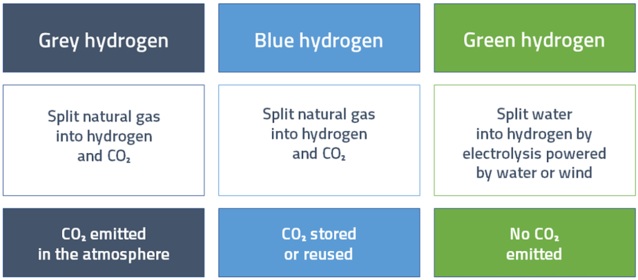Ahmedabad
(Head Office)Address : 506, 3rd EYE THREE (III), Opp. Induben Khakhrawala, Girish Cold Drink Cross Road, CG Road, Navrangpura, Ahmedabad, 380009.
Mobile : 8469231587 / 9586028957
Telephone : 079-40098991
E-mail: dics.upsc@gmail.com

India’s Green Hydrogen Challenge
News: On India’s 75th Independence Day, the Prime Minister announced the National Hydrogen Mission to make the country a production and export hub of green hydrogen.
Background:
Hydrogen is one of the most abundant elements on earth for a cleaner alternative fuel option. There are different types of hydrogen based upon the process of its formation.
What is India’s National Hydrogen Mission?
It is a program to incentivize the commercial production of green hydrogen and make India a net exporter of the fuel.
With an initial outlay of Rs 19,744 crore over the next five years. The target is 5 million metric tonnes production per annum with an associated renewable energy capacity addition of about 125 GW by 2030.
It will lead to savings of $12.5 billion from fuel imports, averting 50 MMTs of annual emissions of Carbon dioxide, fresh investments of $100 billion, and 6,00,000 green jobs.
Advantages of Hydrogen As Fuel
It can be stored for longer duration.
Potential to drive to India's clean energy transition.
Reduced dependence on Fossil Fuels
Rise to newer Green Technologies (estimated to be $18-20 Billion)
Can be used in Industrial and medical applications.
What are the Possible Challenges?
1. Electrolyser Challenge
According to IEA, as of 2021 the global manufacturing capacity of electrolysers stands at 8 GW/year. If India were to achieve its 2030 target, it would need 60-100 GW of electrolyser capacity. It is almost 12 times the current global production capacity.
India currently has launched projects to manufacture electrolysers, but the actual numbers as of today are negligible.
Access to critical minerals such as nickel, platinum group metals and rare earth metals could hinder scaling up electrolyser manufacturing capability in India. These resources are concentrated in countries such as China, Democratic Republic of Congo, Australia, Indonesia, South Africa, Chile and Peru.
India also has limited processing capabilities in these minerals.
2. Energy Source Challenge
As per current estimates a completely efficient electrolysis system would require 39 kWh of electricity to produce 1 kg of hydrogen. Green hydrogen requires renewable energy as a source of electricity.
India currently estimates a capacity of 125 GW of renewable energy to meet its green hydrogen 2030 targets. So far India has only achieved 119 GW of the 175 GW targeted capacity using solar, wind, biopower and small hydro.
In addition to the generation capacity, the transmission capacity for cross-border exchange of power between states is a critical requirement.
3. Endogenous Resources Challenge
It has been estimated that the production of one kg of hydrogen by electrolysis requires around nine litres of water. Moreover, in the case of India, an independent assessment suggests a requirement of approximately 50 billion litres of demineralised water supply. As several parts of India are already severely water-stressed, solutions need to be found to cater to this additional water demand.
4. End-Use Challenge
Currently, most of the demand for hydrogen comes from the chemical industry to produce ammonia for fertilisers, refining for hydrocracking and the desulphurization of fuels. It can be a source of heat for industries such as steel, cement and aluminium production. It can be used as fuel for heavy duty vehicles, aviation and shipping.
The conversion efficiency from one form of energy carrier to another in the end use application will determine the scale of green hydrogen’s applicability.
Hydrogen is a highly combustible and volatile element. Its potency in other forms such as ammonia or methanol is only relatively reduced.
It is critical to establish safety standards for storage and transportation. It will add to the cost of hydrogen as a fuel.
Way Forward:
Scale up large scale manufacturing of electrolysers.
Secure Geo-political partnerships with countries having access to critical minerals.
Proposed green hydrogen hubs will be required to strike a fine balance between availability of renewable energy and being close to hydrogen demand centres for economic feasibility.
It would require India to add efficiently and economically close to 100 GW of overall renewable energy capacity per year over the next seven years and make available dispatch corridors and mechanisms.

Address : 506, 3rd EYE THREE (III), Opp. Induben Khakhrawala, Girish Cold Drink Cross Road, CG Road, Navrangpura, Ahmedabad, 380009.
Mobile : 8469231587 / 9586028957
Telephone : 079-40098991
E-mail: dics.upsc@gmail.com
Address: A-306, The Landmark, Urjanagar-1, Opp. Spicy Street, Kudasan – Por Road, Kudasan, Gandhinagar – 382421
Mobile : 9723832444 / 9723932444
E-mail: dics.gnagar@gmail.com
Address: 2nd Floor, 9 Shivali Society, L&T Circle, opp. Ratri Bazar, Karelibaugh, Vadodara, 390018
Mobile : 9725692037 / 9725692054
E-mail: dics.vadodara@gmail.com
Address: 403, Raj Victoria, Opp. Pal Walkway, Near Galaxy Circle, Pal, Surat-394510
Mobile : 8401031583 / 8401031587
E-mail: dics.surat@gmail.com
Address: 303,305 K 158 Complex Above Magson, Sindhubhavan Road Ahmedabad-380059
Mobile : 9974751177 / 8469231587
E-mail: dicssbr@gmail.com
Address: 57/17, 2nd Floor, Old Rajinder Nagar Market, Bada Bazaar Marg, Delhi-60
Mobile : 9104830862 / 9104830865
E-mail: dics.newdelhi@gmail.com